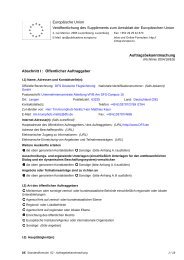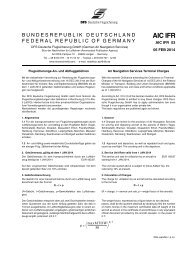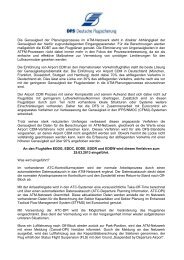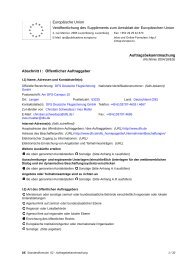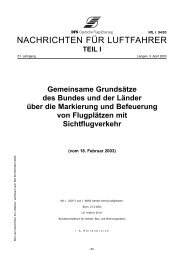TE im Fokus 02/2013 - DFS Deutsche Flugsicherung GmbH
TE im Fokus 02/2013 - DFS Deutsche Flugsicherung GmbH
TE im Fokus 02/2013 - DFS Deutsche Flugsicherung GmbH
Erfolgreiche ePaper selbst erstellen
Machen Sie aus Ihren PDF Publikationen ein blätterbares Flipbook mit unserer einzigartigen Google optimierten e-Paper Software.
Informationen aus dem Bereich Forschung und Entwicklung<br />
der <strong>DFS</strong> <strong>Deutsche</strong> <strong>Flugsicherung</strong> <strong>GmbH</strong><br />
The knowledge of WAM data latency is<br />
the baseline for several surveillance<br />
performance related analyses. An example<br />
which is reflected within this paper<br />
is the dependency between data<br />
latency and the probability of target detection.<br />
6. Probability of Target Detection<br />
A conventional SSR radar system analyzed<br />
with the SASS-C V6.7 tool shows<br />
typically the following characteristic: the<br />
difference of two consecutive radar detections<br />
(t<strong>im</strong>e of detection, ToD) is equal<br />
to the update interval (revolution t<strong>im</strong>e) of<br />
the radar (see Figure 4a). The mean and<br />
median values are usually very close to<br />
each other and the standard deviation is<br />
small. The evaluation software is opt<strong>im</strong>ized in<br />
accordance with this t<strong>im</strong>ing behavior, meaning<br />
that the track correlation and probability of target<br />
detection algorithm were expecting this behavior.<br />
Fig. 4a: Typical ToD difference distribution for radar<br />
A WAM system usually has a different t<strong>im</strong>ing<br />
behavior, because the WAM systems relies as<br />
much as possible on passive detection of reports<br />
initiated by radar and/or TCAS replies and extended<br />
squitter reports (see Figure 4b). Therefore<br />
the difference of two consecutive WAM multilaterations<br />
(t<strong>im</strong>e of arrival, ToA) has mean and<br />
median values which are usually close to each<br />
other. However the standard deviation of the ToA<br />
is quite large. This broad ToA distribution leads<br />
Fig. 4b: Typical ToA difference distribution for WAM<br />
on one hand: “ToA difference is smaller than the<br />
update period” to a situation that the measurement<br />
tool does not expect a new update for the<br />
corresponding target already. Therefore a new<br />
(multiple track) is being generated. On the other<br />
hand: “ToA difference is larger than the<br />
update period” the measurement tool<br />
does expect a new update for the corresponding<br />
target, which is not received in<br />
t<strong>im</strong>e. In both cases the result is the s<strong>im</strong>ilar<br />
- the probability of target detection is<br />
less than expected.<br />
An additional effect on the probability of<br />
target detection is introduced if the corresponding<br />
target report does not contain<br />
altitude data. However, the evaluation<br />
of this data item is subject to the<br />
probability of code detection – Mode C.<br />
Therefore it was decided to modify on<br />
one hand the data (coast the altitude<br />
information in a separate altitude field)<br />
and enhance the processing of the<br />
SASS-C V6.7 tool. Therefore a report<br />
without an altitude data item was still<br />
taken into account for probability of target detection<br />
and the coasted field is correctly evaluated in<br />
the probability of code detection – Mode C<br />
measurement.<br />
The WAM data were adjusted in two steps: Firstly<br />
the altitude information was coasted. After that<br />
this data could still be used for various other<br />
analyses (e.g. horizontal position analyses), because<br />
the correlation of t<strong>im</strong>e and position was<br />
not modified yet. Secondly the t<strong>im</strong>e of arrival in-<br />
Data Performance Analysis of WAM Systems<br />
Ausgabe 2/<strong>2013</strong> Seite 7



